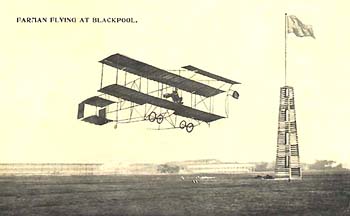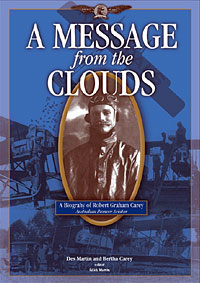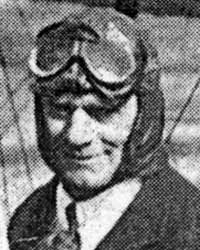
R. G. Carey (1874 - 1959)Edith Martin, daughter of Bertha Harvey (nee Carey) forwarded this synopsis of the wonderful new book 'A Message from the Clouds', launched at Point Cook RAAF Museum on November 8th, 2004. This comprehensive and graphic biography of Robert Graham Carey adds a colourful, much overdue chapter to the whole saga of our early pioneer airmen and women. A Message from the Clouds
A Biography of Robert Graham Carey Carey's Chickens had flown high and wide since their mother hen, a fragile, yet famous little Bleriot winged its way to Point Cook for a life-changing rendezvous. Carey's 50 hp Gnome-engined Bleriot XI was the very same monoplane in which Maurice Guillaux made the first flight from Melbourne to Sydney on July 16,1914.
Or it did, until 1915 when a Ballarat garage proprietor named Robert Graham Carey fortuitously heard about this deserted and famous aircraft. It is understood that this information was relayed through his friendship with a young English pilot, Edwin Prosser, then living in Ballarat. Prosser is believed to have said to Carey: "We ought to buy that." And [we] did! They caught the train to Sydney and made a deal with the Sydney manager for the Messageries Maritime Shipping Company, to offset the holding charges on the crated machine. In need of extensive repairs, the battered Bleriot was transported in its wooden crate by ship from Sydney to Melbourne, then overland to Ballarat. There, Carey induced Edwin T. Prosser, who held R Ae C Certificate No 526, to teach him how to fly. The early adventures of 'rookie' pilot Carey (aka RGC) in the frail Bleriot under Prosser's instruction provides fascinating reading. It was in the time of flying by the seat of your pants' with minimum instrumentation, absence of airfields meant landing in country areas where farmers and the population had their first sight of an aeroplane. Certainly, cattle, horses and sheep were frightened as the huge 'bird' alighted in their paddocks, but passengers and observers spoke excitedly about their experiences, which have been preserved in the birdman's massive scrapbook. The Carey family has in their possession copious documentation and original photos preserving RGC's many ventures that also include his long and most interesting career in motoring.
On November 23, 1916, forty-two year old Robert Graham Carey flew his Bleriot monoplane to Point Cook via Bacchus Marsh to undergo his flying test. His two Central Flying School examiners had the power invested in them by the Royal Aero Club of Great Britain to pass student pilots for the Australian Flying Corps and also for civilian operations. The result was a foregone conclusion. RGC flew home the proud possessor of the Australian Aero Club Aviator's Certificate No. 34 as granted to him on that date, signed by Lieutenant Eric Harrison. This was the first pilot's certificate issued to a civilian in Australia; furthermore Carey was the first Australian born pilot to obtain an official commercial flying permit. As a legally qualified pilot there was no holding Carey back, he continued to fly all around his base at Ballarat to give country people their first introduction to an aeroplane. He also opened the Ballarat Flying School with Edwin Prosser as its Chief Instructor, a position he took over himself at a later date. The flying school must rate as probably the first of its kind in Victoria. Besides the training of pilots, activities included barnstorming, advertising ventures, aerial photography and the transport of mail, freight and passengers. In all of these Carey offered expertise, for indeed he was an undisputed Australian trailblazer in Civil Aviation during and after World War I. Considered too old for war service, he was refused admission to the Australian Flying Corps; notwithstanding, Carey gave of his time and talents unstintingly to promote wartime appeals and charities. In 1916, newspaper accounts report Carey's flight in the tiny Bleriot over Adelaide during a fierce storm on an Army Nurses' Day event to boost the war effort. RGC distributed 'a Message from the Clouds' in war bond and enlistment dodgers while piloting his Bleriot. In November 1917, Carey flew his Bleriot with the first Airmail from Adelaide to Gawler and in 1957 was able to attend the re-enactment in South Australia at its 40th Anniversary, aged 83. He handed a bag of mail to the same person who had received that first airmail bag. After several busy years Carey expanded his operations and the rotary engine Bleriot 50 found itself in dusty retirement due to the scarcity of spare parts. Nevertheless this remarkable antique aircraft was eventually restored and is displayed in the Power House Museum at Ultimo, Sydney. Early in 1919, the Carey family moved from Ballarat to the Melbourne suburb of Port Melbourne. RGC purchased a church hall and had it transported from Brighton to his private aerodrome, on leased Crown land beside the Port Melbourne Rifle Range. He located the hall next to the fence line beside the Rifle Range Clubhouse buildings well back from Williamstown Road. Carey, Edith and four children lived in the hall that RGC converted into the family residence and office. Right from the start RGC's motto was 'Safety First'. He considered stunting to be the purlieus of the fighter pilot and saw no reason to include it during his commercial aviation activities. In his subsequent thirty years of flying Carey experienced his share of forced landings and setbacks, as did his fellow pioneers, yet commendably, it is claimed that there were no injuries received by the 70,000 passengers he is reported to have carried. Carey's private aerodrome at Port Melbourne, became the roost from which the chickens of Australian commercial aviation emanated to carry names such as ANA, East-West, Ansett, and Qantas, across Australian and international skies. On March 16, 1919, Carey and the then Mayor of Essendon, Ald. Arthur Fenton, purchased four obsolete Maurice Farman Shorthorn biplanes from the Department of Defence (Point Cook). Carey dubbed them 'Carey's Chickens', which he had derived from the legendary Stormy Petrels, known as 'Mother Carey's Chickens'. RGC's application of this name to his aircraft at the time of their delivery to Port Melbourne arose from references to Carey as 'The Stormy Petrel' because of his storm defying flight over Adelaide in the Bleriot, October 1917. Part of the Farman acquisition deal was a conversion course to fly Farmans for the purchasing pilot with Lieutenant WH Treloar to be the instructor. A quiet achiever, Harold Treloar was one of the AFC's most experienced pilots who had been posted during WWI to the Mesopotamian Half Flight. Forced down by a faulty engine, he and his Indian Army observer were captured and given a rough time by the Arabs and Turks as prisoners of war. RGC and Treloar became good friends during Carey's instruction on operation and maintenance of the Farmans. Treloar and three other Central Flying School pilots delivered the Farmans from Point Cook to the refurbished landing ground at Port Melbourne on Saturday, April 11, 1919. Since the Farman's hangar was not yet ready, the four machines were tied down in the open. A huge gale blew across Hobson's Bay and struck the aerodrome causing damage to all the Farmans, two were hit so badly that they were reduced to spare parts. The other two were fully restored and later registered as G-AUCW and G-AUBC. The four Farmans were all composite machines because they had been damaged and repaired during air cadet training; likewise, the remains of RGC's wrecked Farmans, plus the extra engine and parts from the original sale, provided Carey with all the spares he needed for many years. With the first Commercial (Aviation) Permit, RG Carey inaugurated Melbourne Air Service and for many years Carey made headlines with his Farman shorthorns involved in events all over Melbourne environs and the Victorian countryside. Notwithstanding his news making aerial delivery of Easter Hot Cross Buns to Philip Island, he flew avid race goers to country meetings, promoted community events and carried such cargo as 'Pals' boys' magazines to name just a few of his ventures. RGC continually used his planes for advertising with painted signage on the underside of both lower and upper wings as well as the rudders and nacelle. Carey's extensive 'Message from the Clouds' promotion records cover War and Peace Loan flyers, Vacuum Oil Company, Wangaratta Woollen Mills, charity and sporting events, various traders' association shop locally campaigns, Palm and Cubitt brand cars and Velvet Soap. Dodgers (leaflets) were scattered from the plane overhead as a novel marketing device similar to that of towing aerial banners or sky writing objectives today. Mindful of promoting his own aviation and motoring business, Carey periodically included huge captions on his planes such as 'Carey's Chickens', 'Melbourne Air Service' or 'Carey's Auctions'. Carey's most publicised and ambitious aerial advertising campaigns for the Herald and Weekly times 'Pals' magazine was announced in the Melbourne Herald, on Wednesday, September 22, 1920. The front-page story, with a five-column picture of the 'Pals Plane' with the Carey family in front of it, declared that RGC would begin an epic journey from Melbourne to the Gulf of Carpentaria in the coming week. Sub-titles announced ''Pals' Aeroplane To Cross Australia', and ''Pals' Aeroplane Carries Message To Australian Boys'. Around the Farman narcelle was painted the word 'Pals', and clearly visible as the plane flew overhead, the message: 'Boys' and 'Read Pals' emblazoned across the wingspan. The tour was discontinued at Forbes however, probably due to problems with supply and finance. A journal by Miss Maisie Carey and her mother provides insight into the difficult conditions encountered during long distance motor travel in the late 1920s. The 'Pals' slogan later became 'Palm' during Carey's comprehensive air tour for the Palm cars company. Various slogans graced the Farman wingspan during Melbourne Air Service years as Carey drew more and more attention from his advertising ventures. Subsequently, Carey and his Farmans advertised Cubitt brand cars and then Velvet Soap, followed by various promotions for Progress Associations that were keen to see the Farman slogan 'Shop Locally' over their particular district. Carey was kept busy with Melbourne Air Service activities, developing Melbourne Flying School, grasping every opportunity to offer 'joy' flights throughout Victoria and border towns, passionate to enthuse all contacts with the thrill of the air. He was a capable and enthusiastic public speaker and as such was invited to speak on aviation matters at state and federal government levels, motoring associations and schools while continuing to manage his motoring business and partake in numerous long distance car rallies. RGC was born in Warrnambool, Victoria and moved with his family to Melbourne when he was 5 years old. At the tender age of 10 began his first business venture carrying wood and coal by wheelbarrow as well as selling newspapers in Port Melbourne. In 1894, aged 20 Carey was the sole proprietor of a carrying firm in Heath Street, Port Melbourne and by 1900 he registered the Port Melbourne Livery Stables in association with his existing hay and corn store. Meanwhile Carey had married Edith Gilchrist in 1899 and built up his team of fine horses and carriages for hire to include a taxi and motor hire service. In 1912 the Carey family moved to Ballarat where he built up a very successful motoring business, learnt to fly his Bleriot, and in 1919 returned to the Port Melbourne district again to further his aviation passion. With wife Edith, and 6 children, Carey not only ran a thriving business but also involved himself in numerous civic interests. A life member of the Australian Natives Association, belonged to the Ancient Order of Druids, and was awarded a Life Governor membership for services with the Freemason's Homes of Victoria Citizen's Lodge. Carey was among the first members of the RACV and the VACC with many magazine articles applauding his motoring and aviation ventures published in early club magazines. Melbourne and country newspapers constantly found his activities newsworthy and these records have provided a marvelous source of additional information for the RGC biography. Carey (63) last piloted a plane, flying one of his Farmans from Port Melbourne on the Coronation Day of King George V1th, May 12, 1937. About this time RGC and family decided to concentrate their efforts on the motor trade. Carey had sold off one of the Farmans and eventually surrendered the Port Melbourne airfield lease. After auctioning off surplus stock from Melbourne Air Service, he spent a few years in his motor business at Wangaratta, eventually retiring to the family home in Chelsea where he had stored so many of the aeroplane parts including a Farman engine not sold at the Port Melbourne auction. He indulged his love of auction sales and finished up with a museum cum junkyard, full of weird and wonderful relics, including two tramcars plus an abundance of spare car parts and war surplus. One of his Farmans was meticulously restored at Mentone by Mr Fred Edwards and recorded on film whilst being flown at Moorabbin 1956 in the presence of Mr. Carey aged 82 years. This Farman is now proudly displayed in the Canada Aviation Museum in Ottowa. It was a great disappointment that the Australian Government of the time did not see fit to purchase this Farman, however we are thankful that she was appreciated in America and is now preserved in Canada. Thanks to the dedicated efforts of RAAF staff and volunteers using a few original parts donated from Carey's estate, and all other components painstakingly designed and constructed, they achieved a magnificent Farman now exhibited at the RAAF Museum Point Cook. Civilian aviator Carey would have been overwhelmingly grateful to witness this tribute to the Maurice Farman S11 Shorthorns, home to roost at historical Point Cook. Robert Graham Carey, the man who learnt to fly in a Bleriot XI monoplane, had lived through two world wars to see the advent of space exploration, with aircraft being invented that a decade later would enable men to walk on the moon. Although modern aviators in the jet age of electronic space machines may claim center stage over Carey, he was indeed a major player in Australian aviation history and his spirit shines in the stars. No record of the early flying days would be complete without the inclusion of this colorful personality. His was a wonderful work - educating people to air safety.
Image: courtesy the Hearn Family
In 1916, the Australian Flying Corps(AFC) introduced the Maurice Farman Shorthorn into service as a trainer at Point Cook. CFS-15 was the first of type into service, and until replacement by more modern trainers in 1919, was used to train pilots in the AFC for service both at home and overseas. In 1919, Mr R. G. Carey of Port Melbourne purchased CFS-15 for use in advertising, joyflights and barnstorming, now registered as G-AUBC. Carey flew the aircraft until the 1930s, after which it was stored. By the 1980's, the aircraft had virtually disappeared, and in 1981, Carey's daughter [Bertha Harvey] donated the remaining components to the RAAF Museum. After the completion of the Demon project in 1986, the Museum began the restoration of CFS-15 for display. Containing approximately 30% original parts, and fitted with a 75hp Wolseley-Renault engine, CFS-15 was put on display in 1997.
RAAF Museum, Point Cook, Victoria, Australia
More about the Maurice Farman S.11 Shorthorn can be found at the following sites...
The Aerodrome
Early War Aeroplanes
Henri Farman 1874-1958 Henri Farman was born in Paris of English parents on May 26, 1874. Although educated at the Paris School of Fine Arts as a painter, his first honors were as a bicycle racer and later an auto-racing champion. With his brother, Maurice, Henri learned to fly in a Voisin and shortly thereafter, in 1907, ordered his own aircraft incorporating his design modifications of a dihedral in the wings and the reduction of the tail to a single plane. These intuitive rather than scientific modifications were the first steps in a long career in which Henri Farman diagnosed and solved a myriad of aircraft control and structural problems.
 The Farman Biplane at Blackpool, England, 1909 A 500 pixel or 1000 pixel image may also be downloaded
On January 13, 1908, in his modified craft, Henri Farman won the prestigious Archdeacon prize by demonstrating his ability to fly a circuit of one kilometer, even with lateral control problems. In 1908, the incorporation of the first efficient ailerons provided the solution to this enormously difficult and dangerous problem. In 1909, Henri Farman began one of the first formal, flight training schools and in 1914 founded the Farman Aviation Works that produced more than 12,000 military aircraft for France in World War I. In succeeding years the brothers Henri and Maurice, now joined by Dick, enjoyed both financial and technical success with a series of advanced designs, including the twin-engined Goliath capable of carrying twelve passengers. With this aircraft, they established their airline, Farman Lines, which was a forerunner of Air France. Henri Farman was at the forefront of European aviation development from its infancy to maturity. His analytical skills, piloting ability and uncommon business acumen, contributed to France's major role in world aviation until his death in 1958. http://www.allstar.fiu.edu/aero/farman.htm
|
© Copyright 1999-2005 CTIE - All Rights Reserved - Caution |

